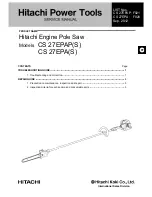
7
WARNING:
Know your Plunge cut
circular saw. Do not plug the saw into the
power source until you have read and
understand this Instruction Manual. Learn
the tool’s applications and limitations, as
well as the specific potential hazards related
to this tool.
Following this rule will reduce the
risk of electric shock, fire, or serious injury.
Always wear eye protection. Any
power tool can throw foreign
objects into your eyes and cause
permanent eye damage.
ALWAYS wear safety goggles (not glasses) that
comply with ANSI safety standard Z87.1.
Everyday glasses have only impact resistant
lenses. They ARE NOT safety glasses.
WARNING:
Glasses or goggles not in
compliance with ANSI Z87.1 could cause
serious injury when they break.
Always keep hands out of the path of the saw
blade. Avoid awkward hand positions where a
sudden slip could cause your hand to move into
the path of the saw blade.
DANGER:
Keep hands away from
cutting area and the blade. Keep your
second hand on the tool.
If both hands are
holding the saw, they cannot be cut by the blade.
Do not reach underneath the workpiece.
The
guard cannot protect you from the blade below
the workpiece.
Adjust the cutting depth according to the
thickness of the workpiece.
Less than a full
tooth of the blade teeth should be visible below
the workpiece or approximately 3/8” (10mm).
Never hold piece being cut in your hands or
across your leg. Secure the workpiece to a
stable platform.
It is important to support the
work properly to minimize body exposure, blade
binding, or loss of control.
When ripping always use a straight edge
guide.
This improves the accuracy of cut and
reduces the chance of the blade binding..
Hold power tool by insulated gripping
surfaces when performing an operation
where the cutting tool may contact hidden
wiring or its own cord.
Contact with a “live”
wire will also make exposed metal parts of the
power tool “live” and shock the operator.
Always use blades with correct size and
shape (diamond versus round) of arbour
holes.
Blades that do not match the mounting
hardware of the saw will run eccentrically,
causing loss of control..
Never use damaged or incorrect blade
washers or bolt.
The blade washers and bolt
were specially designed for your saw, for
optimum performance and safety of operation.
CAUSES AND OPERATOR PREVENTION OF
KICKBACK.
Kickback is a sudden reaction to a pinched,
bound or misaligned saw blade, causing an
uncontrolled saw to lift up and out of the
workpiece toward the operator;
When the blade is pinched or bound tightly by
the kerf closing down, the blade stalls and the
motor reaction drives the unit rapidly back
toward the operator.
If the blade becomes twisted or misaligned in
the cut, the teeth at the back edge of the blade
can dig into the top surface of the wood causing
the blade to climb out of the kerf and jump back
toward the operator.
Kickback is the result of saw misuse and/or
incorrect operating procedures or conditions and
can be avoided by taking proper precautions as
given below:
Maintain a firm grip with both hands on the
saw and position your arms to resist
kickback forces. Position your body to the
left or right side of the blade, but not in line
with the blade.
Kickback could cause the saw
to jump backwards, but kickback forces can be
controlled by the operator, if proper precautions
are taken.
SPECIFIC SAFETY RULES
SAVE THESE INSTRUCTIONS FOR REFERENCE








































